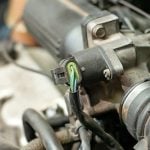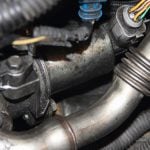P0183 error code indicates Fuel Temperature Sensor “A” Circuit High. To put it plainly, the PCM gets a reading on the fuel’s temperature from the fuel temperature sensor, but the mechanics behind it is something to look out for.
What is the P0183 code?
The PCM receives the appropriate signal from the fuel temperature sensor, which measures the fuel’s temperature and transmits it to the PCM. The higher the signal, the colder the temperature and the higher the fuel density. The computer calculates the fuel density and then uses the signals to adjust the fuel system and the engine as a whole.
The PCM utilizes the fuel temperature sensor to fine-tune the air-fuel ratio. This aids the engine in obtaining the precise amount of fuel it requires to handle the workload. By reducing the unburned fuel amount that exits the engine and exhaust system, it also reduces emissions.
The PCM checks the fuel temperature sensor signal regularly and compares the resistance to predetermined values. If the computer does not receive the correct response from the sensor, it will set the powertrain code P0183.
Where is the fuel temperature sensor located?
It is located on the fuel rail, close to the fuel injectors. It allows it to monitor the fuel’s heat accurately.
Causes
- When you test the sensor during startup or operation, the PCM detects a voltage above the sensor’s specified range.
- Faults in wiring, connections, or the PCM can cause intermittent open circuits.
- A contaminated connector causes an intermittent opening in the circuit connection of the fuel tank or fuel rail temperature sensor.
- There is a problem with the powertrain control module (PCM)
- If a fault occurs or the ambient temperature drops below -40 degrees F, the sensor will fail.
Symptoms
- Due to the volatility of the fuel, if the fuel is too cold, the vehicle may not start.
- Fuel additive overuse can lead to unpredictable engine performance, including stalling and hesitation.
Diagnosis
- Clears the codes to see if the code returns after scanning and documenting the freeze frame data.
- Do a visual inspection of the sensor’s wiring and connections to look for any shorts or loose connections.
- Ensure that the sensor is working properly by disconnecting the connection and running tests.
- Takes a sample of fuel and compares it to the sensor’s readings.
- Run various tests to verify that the diesel fuel heater is working properly and that the fuel is not overheating.
- Make a visual inspection of the sensor’s connections to ensure that there is no shortage in the harness and that there is no fuel contamination in the connector, which can cause shorts.
- Check for excessive additives in the fuel, as they lead to sensor failures.
Is the P0183 error code a serious one?
The code won’t cause immediate issues to your car’s engine. However, if the fuel temperature drops below normal operating temperatures due to the weather, the engine may misfire, hesitate, or even stall. If the PCM detects a fault, it may alter the vehicle’s fuel pressure or fuel injection.
Fixing the P0183 error code
- If the fuel temperature sensor fails to meet specifications, it should be replaced.
- Repairing or replacing a sensor’s connector or wiring.
- Adding a temperature sensor to the diesel fuel heater assembly.
- Check the wires and their connectors for signs of oxidation or burns. If such characteristics are discovered, repair or replace them.
Using a digital multimeter (FTS), ensure that the Fuel Temperature Sensor’s connector has a reference voltage and a ground connection. If the PCM connector does not have a reference voltage, use a multimeter to check the parallel circuits. Poor PCM programming could explain a lack of voltage at the PCM connector.
An oscilloscope can display live data in a waveform with a good ground and a reference voltage. Test leads should be connected to the ground and signal circuits. Look at the displayed waveforms to see how the patterns evolve.
Use an infrared thermometer to measure the real temperature of the fuel, and compare it to the oscilloscope reading. A malfunctioning fuel temperature sensor should be replaced if the two readings don’t match.
What specific steps are involved in replacing the fuel temperature sensor?
Start by disconnecting the battery, locating the sensor on the fuel rail, removing the sensor’s wiring harness, unscrewing the sensor, and replacing it with a new one. Then, reconnect and test.
All Your Questions Answered
It indicates that the PCM got a response from the fuel temperature sensor that did not match the baseline readings.
It implies “Fuel Temperature Sensor ‘A’ Circuit High.” This code indicates that the PCM received a fuel temperature sensor response that did not match the base readings.
It implies the “Fuel Temperature Sensor ‘A’ Circuit High.”
Yes, extreme heat or cold can make P0183 errors worse, as they cause the fuel to expand or contract, pushing the sensor to its limits.
When a fuel temperature sensor fails, it can misread fuel temperature, causing engine misfires, poor fuel economy, and unexpected stalling. This often leads to a check engine light illuminating.
Yes, if you notice poor fuel efficiency, irregular idling, or difficulty starting, the sensor might be the culprit. A scan tool can confirm this with error codes like P0183.

Sara Sam may not look like your typical car and finance expert, but don’t let that fool you. With over four years of experience in the industry, she knows all the ins and outs of cars, car insurance, and refinancing. You can trust Sara to help you navigate the often-confusing world of automobiles and financing.



















